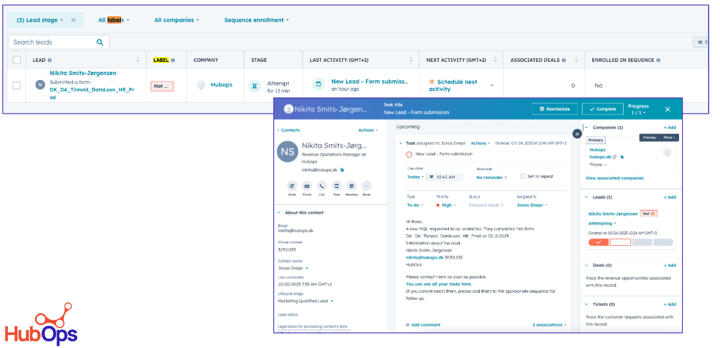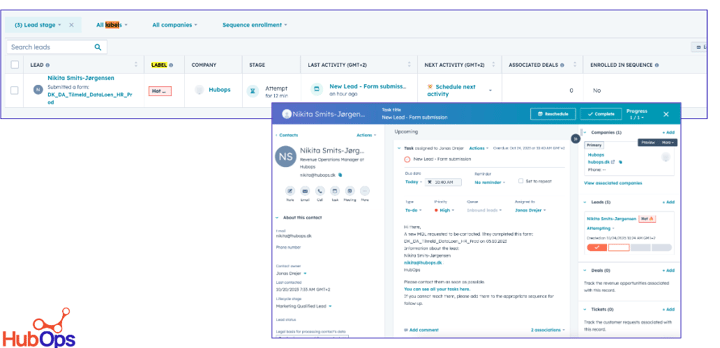Optimizing Lead Qualification: HubSpot Leads vs. Stage 0 Deals
Explore the differences between using HubSpot leads and stage 0 deals in the lead qualification process to maximize your conversion rates.
First step: Define your qualification criteria
Depending on the nature of your organization, sales strategy, and market approach, the lead qualification process can vary significantly across different companies and even within different departments of the same company.
To streamline this process, consider asking three key questions:
- Who should we prioritize for meetings?
- What criteria must be met before scheduling a meeting with our AE team?
- How do we define a qualified Opportunity?
For instance, a qualification criteria framework may combine elements of ICP, BANT, and MEDDIC, focusing on factors like whether the account fits the ICP, the presence of a clear need or pain point, and the contact's authority to champion the solution.
Tailoring these criteria to your organization's specific needs is essential for effective lead qualification and conversion.
Inbound and outbound motions might have a slightly different flow. For inbound motions, it's crucial to determine what information needs to be confirmed before passing the lead to your AE team. This step is especially valuable as it allows for a qualification call to assess the prospect's fit. On the other hand, outbound prospects may have limited publicly available information, making it challenging to gather insights during cold outreach. I would always recommend mapping out all of your processes in an easy-to-read visual.
 Understanding HubSpot Leads
Understanding HubSpot Leads
HubSpot leads are more than just a standalone entity; they are intricately linked to a contact, much like how a quote is connected to a deal. While they may not provide a wealth of information alone, when combined with the contact, they paint a comprehensive picture of your ongoing engagement and guide your next steps. Instead of viewing the lead as a mere stepping stone to a contact, I see it as a precursor to a potential deal.
The first step is to generate a contact through interest in your marketing material or by researching potentially interesting outbound prospecting. Ideally, you'd surface the most qualified leads through a combination of Marketing and Sales engagement as well as scoring.
Challenges with Customization in HubSpot Leads
But there we get to the challenges! The associated objects panel provides quick access to lead details, allowing sales representatives to easily view important information such as lead source, lead status, and any associated activities. This streamlined approach enables sales teams to efficiently track and nurture leads throughout the sales process. So far so good but that's it.
The HubSpot lead object and the prospecting workspace came out of beta in the fall of 2023 which hasn't been a very long time. The product works and serves a clear function but as with many HubSpot products when they're first released: There is very little opportunity to customise your setup.
The lead object isn't a true object. It doesn't stand on its own, you cannot create custom properties (yet, I hope) and when a user without a paid sales seat wants to run lists or analyze your leads they're running into a massive challenge: They cannot see the leads! This to me is the biggest detractor as I would always advocate for absolute transparency across teams in your CRM. I hope and expect that this will become easier when HubSpot moves to the new seat-based pricing in March 2024 but you might not want to switch depending on your current contract. Just like when they changed their pricing from contacts to marketing and non-marketing contacts, for some people, the new pricing was a great way to renegotiate their agreement while for others there wasn't a clear benefit.
Introducing Stage 0 Deals
So then what? For some businesses, specifically the ones that use HubSpot together with another CRM such as Salesforce it might mean they aren't changing their setup just yet. I can imagine you have a less-than-perfect setup where you create leads in Salesforce and you have to deal with some duplicates and hygiene issues but switching is too much. Or you do not use another CRM and just work with HubSpot Marketing and Sales but you need to customise your lead setup further.
Another way to go about this early qualification is to generate a Stage 0 Deal.
Stage 0 Deals represent the early stage of the sales process where leads are identified as potential opportunities but have not yet progressed to a defined sales stage. Introducing Stage 0 Deals allows businesses to track and manage these opportunities separately from other leads, providing a clear distinction for prioritization and follow-up.
By assigning contacts to Stage 0 Deals, sales teams can focus on nurturing these opportunities and moving them closer to conversion.
I've been on both sides of the fence here. I like the customisation options you have using a Stage 0 deal but I don't like the additional work entailed to generate a deal versus a lead and I don't like how you'll have to caution your low opportunity creation to closed won conversion rate.
Utilizing Workflows to Streamline Stage 0 Deal Generation
Workflows in HubSpot can be leveraged to automate and streamline the process of generating Stage 0 Deals. By setting up automated workflows based on specific criteria and triggers, businesses can automate the creation of Stage 0 deals in bulk and relatively easily. Your team must be aware of what's needed to qualify these deals and how to either unqualify or progress them to be a true opportunity.
What are the qualification criteria to move a Stage 0 deal to a true deal that was defined earlier? Are you getting this information in your current process or would your qualification process need an overhaul as well?
Implementing a Hybrid Approach
For some motions, leads might be the way to go. If the quality of your inbound hand-raisers is quite high, a stage 0 deal might be a great way for SDRs to hand over qualified prospects to your AEs. They've confirmed the business is within your ICP and have had a quick qualification call while setting up a meeting for a demo.
If your demo requests come from paid traffic and you haven't refined the quality of them just yet, creating deals might be overkill as there is a very low conversion rate.
If your Sales team has several customisation requests you might be better off using a Stage 0 deal as the 'handover mechanism. If they don't, leads might be enough and give them a clear distinction between working on their leads versus on their deals.
To leverage the best option in various scenarios, businesses can implement a hybrid approach that combines the strengths of both strategies. By integrating customized workflows, lead scoring models, and automated processes, businesses can effectively qualify leads and drive them towards conversion.
An integrated approach allows businesses to leverage the unique advantages of HubSpot Leads and Stage 0 Deals while addressing the specific needs and challenges of their lead qualification process.
As always, you want to make sure you enable your team to leverage the setup fully.
Ensure that Service Level Agreements (SLAs) and review cadences are established clearly.
Common challenges to address:
- After a meeting has taken place and the outcome is evident, team members may lag in updating the CRM system. The solution lies in implementing automated reminders, generating reports, and having managers intervene as needed. It is vital to regularly review the list of meetings that require attention.
- In the case of a meeting being a no-show, it is crucial to determine how long the Sales Development Representative (SDR) should attempt to reschedule before closing it out. Having a consistent protocol in place for handling this situation is key.
- In situations where there is a disagreement between parties regarding the qualification of a meeting, having a structured system for resolving disputes is essential. Ensuring that previous qualification assessments and the rationale behind them are accessible and utilized as evidence can help in resolving.
To recap, to determine which mechanism works best for your organisation, I would recommend fully mapping out your processes and understanding the needs for your inbound VS outbound motion or even to see if different teams who target different segments might benefit from a different setup. Once you do, determine who each progression down the funnel is qualified and how much customisation you need.





